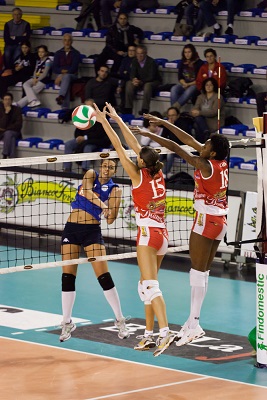Inventor of Volleyball
The inventor of volleyball is William G. Morgan.
History of volleyball and original game rules
Volleyball was created in 1895 by Springfield College graduate William G. Morgan.
Volleyball was developed from the combination of tennis, basketball, handball and baseball.
The first volleyball net was taken from a tennis net and was only 6 feet 6 inches high.
During the winter of 1895-96, the inventor of volleyball Mr. William G. Morgan of Holyoke, Massachusetts, developed a game in his gymnasium which he named Volley Ball.
This game was presented to the succeeding Physical Directors Conference and the general impression seemed to be that it would fill a place not filled by any other game.
The appeal was the fact you play indoors and it wasn't so rough as basketball.
The new game of volleyball
Volley Ball is a new game which is pre-eminently fitted for the gymnasium or the exercise hall.
It's also possible to play the game outdoors.
Inventor of Volleyball William G. Morgan
Development of Volleyball
Any number of persons may play the game.
The play consists of keeping a ball in motion over a high net, from one side to the other, thus partaking of the character of two gamestennis and hand ball.
Play is started by a player on one side serving the ball over the net into the opponents field or court.
The opponents then, without allowing the ball to strike the floor, return it, and it is in this way kept going back and forth until one side fails to return it or it hits the floor.
This counts a score for one side, or a server out for the other, depending on the side in point.
In the beginning, the inventor of volleyball created a game consisting of nine innings, each side serving a certain number of times, as per the rules, per inning.
Original Rules of Volleyball
According to the inventor of volleyball, the following are the original rules for playing the game of Volley Ball...
- The game consists of nine innings.
- An inning consists of: when one person is playing on each side, one service each side; when two are playing on each side, two services each side; when three or more are playing on each side, three services each side. The man serving continues to do so until out by failure of his side to return the ball. Each man shall serve in turn.
- The court or floor space shall be 25 feet wide and 50 feet long, to be divided into two square courts, 25 by 25 feet, by the net. Four feet from the net on either side and parallel with it shall be a line across the court, the Dribbling line. The boundary lines must be plainly marked so as to be visible from all parts of the court. Note: The exact size of the court may be changed to suit the convenience of the place.
- The net shall be at least 2 feet wide and 27 feet long and shall be suspended from uprights placed at least 1 foot outside the side lines. The top line of the net must be 6 feet 6 inches from the floor.
- The ball shall be a rubber bladder covered with leather or canvas. It shall measure not less than 25 inches, nor more than 27 inches in circumference, and shall weigh not less than 9 ounces nor more than 12 ounces.
Inventor of Volleyball - Rules
- The server shall stand with one foot on the back line. The ball must be batted with the hand. Two services or trials are allowed him to place the ball in the opponents court (as in tennis). The server may serve into the opponents court at any place. In a service, the ball must be batted at least 10 feet, no dribbling allowed. A service which would strike the net, but which is struck by another of the same side before striking the net, if it goes over into the opponents court, is good, but if it should go outside, the server has no second trial.
- Each good service unreturned or ball in play unreturned by the side receiving counts one score for the side serving. A side only scores when serving, as a failure to return the ball in their part results in the server being put out.
- A play which hits the net, aside from first service, is called a net ball, and is equivalent to a failure to return, counting for the opposite side. The ball hitting the net on first service shall be called dead, and counts as a trial.
- It is a ball striking the boundary line. It is equivalent to one out of court, and counts as such.
- The inventor of volleyball had the intent of any number of people playing at once. A player should be able to cover about 10 by 10 feet. Should any player during play touch the net, it puts the ball out of play and counts against his side. Should any player catch or hold for an instant the ball, it is out of play and counts for the opposite side. Should the ball strike any object other than the floor and bound back into play, it is still in play. To dribble the ball is to carry it all the time, keeping it bouncing. When dribbling the ball no player shall cross the dribbling line, this putting the ball out of play and counting against him. Any player except the captain, addressing the umpire or casting any slurring remarks at him or any of the players on the opposite side, may be disqualified, and his side be compelled to play the game without him or a substitute, or forfeit the same.
Tips for Playing Volleyball
From the inventor of volleyball, tips for playing Volley Ball...
- Pass from one to another when possible.
- Look for uncovered space in the opponents field.
- Play together; cover your own space.
- Strike the ball with both hands.
- Watch the play constantly, especially the opponents.
If you enjoyed these tips and would like to keep it close to you at any time, just save this pin to your Pinterest Volleyball Training Board.
Home › Volleyball History › Creator of Volleyball





